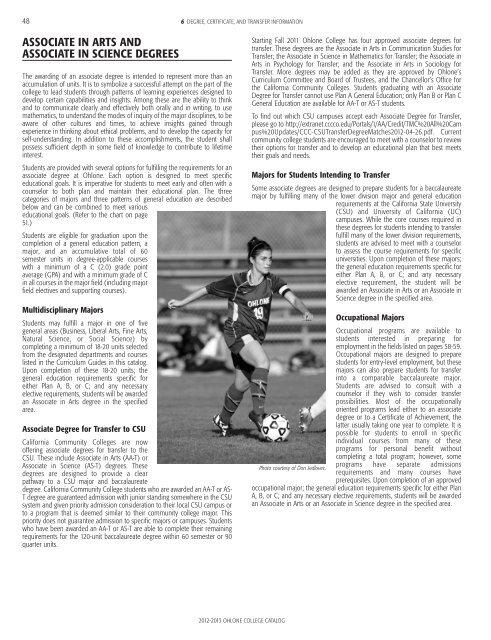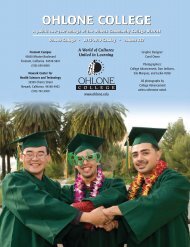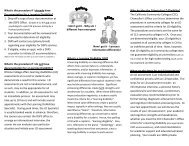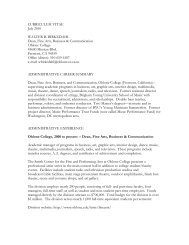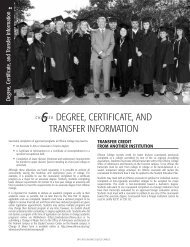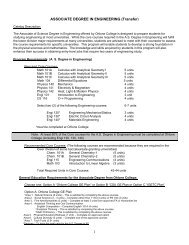2012-2013 Catalog (all pages) - Ohlone College
2012-2013 Catalog (all pages) - Ohlone College
2012-2013 Catalog (all pages) - Ohlone College
You also want an ePaper? Increase the reach of your titles
YUMPU automatically turns print PDFs into web optimized ePapers that Google loves.
48 6 DEGREE, CERTIFICATE, AND TRANSFER INFORMATION<br />
ASSOCIATE IN ARTS AND<br />
ASSOCIATE IN SCIENCE DEGREES<br />
The awarding of an associate degree is intended to represent more than an<br />
accumulation of units. It is to symbolize a successful attempt on the part of the<br />
college to lead students through patterns of learning experiences designed to<br />
develop certain capabilities and insights. Among these are the ability to think<br />
and to communicate clearly and effectively both or<strong>all</strong>y and in writing, to use<br />
mathematics, to understand the modes of inquiry of the major disciplines, to be<br />
aware of other cultures and times, to achieve insights gained through<br />
experience in thinking about ethical problems, and to develop the capacity for<br />
self-understanding. In addition to these accomplishments, the student sh<strong>all</strong><br />
possess sufficient depth in some field of knowledge to contribute to lifetime<br />
interest.<br />
Students are provided with several options for fulfilling the requirements for an<br />
associate degree at <strong>Ohlone</strong>. Each option is designed to meet specific<br />
educational goals. It is imperative for students to meet early and often with a<br />
counselor to both plan and maintain their educational plan. The three<br />
categories of majors and three patterns of general education are described<br />
below and can be combined to meet various<br />
educational goals. (Refer to the chart on page<br />
51.)<br />
Students are eligible for graduation upon the<br />
completion of a general education pattern, a<br />
major, and an accumulative total of 60<br />
semester units in degree-applicable courses<br />
with a minimum of a C (2.0) grade point<br />
average (GPA) and with a minimum grade of C<br />
in <strong>all</strong> courses in the major field (including major<br />
field electives and supporting courses).<br />
Multidisciplinary Majors<br />
Students may fulfill a major in one of five<br />
general areas (Business, Liberal Arts, Fine Arts,<br />
Natural Science, or Social Science) by<br />
completing a minimum of 18-20 units selected<br />
from the designated departments and courses<br />
listed in the Curriculum Guides in this catalog.<br />
Upon completion of these 18-20 units; the<br />
general education requirements specific for<br />
either Plan A, B, or C; and any necessary<br />
elective requirements, students will be awarded<br />
an Associate in Arts degree in the specified<br />
area.<br />
Associate Degree for Transfer to CSU<br />
California Community <strong>College</strong>s are now<br />
offering associate degrees for transfer to the<br />
CSU. These include Associate in Arts (AA-T) or<br />
Associate in Science (AS-T) degrees. These<br />
degrees are designed to provide a clear<br />
pathway to a CSU major and baccalaureate<br />
degree. California Community <strong>College</strong> students who are awarded an AA-T or AS-<br />
T degree are guaranteed admission with junior standing somewhere in the CSU<br />
system and given priority admission consideration to their local CSU campus or<br />
to a program that is deemed similar to their community college major. This<br />
priority does not guarantee admission to specific majors or campuses. Students<br />
who have been awarded an AA-T or AS-T are able to complete their remaining<br />
requirements for the 120-unit baccalaureate degree within 60 semester or 90<br />
quarter units.<br />
Starting F<strong>all</strong> 2011 <strong>Ohlone</strong> <strong>College</strong> has four approved associate degrees for<br />
transfer. These degrees are the Associate in Arts in Communication Studies for<br />
Transfer; the Associate in Science in Mathematics for Transfer; the Associate in<br />
Arts in Psychology for Transfer; and the Associate in Arts in Sociology for<br />
Transfer. More degrees may be added as they are approved by <strong>Ohlone</strong>’s<br />
Curriculum Committee and Board of Trustees, and the Chancellor’s Office for<br />
the California Community <strong>College</strong>s. Students graduating with an Associate<br />
Degree for Transfer cannot use Plan A General Education; only Plan B or Plan C<br />
General Education are available for AA-T or AS-T students.<br />
To find out which CSU campuses accept each Associate Degree for Transfer,<br />
please go to http://extranet.cccco.edu/Portals/1/AA/Credit/TMC%20All%20Cam<br />
pus%20Updates/CCC-CSUTransferDegreeMatches<strong>2012</strong>-04-26.pdf. Current<br />
community college students are encouraged to meet with a counselor to review<br />
their options for transfer and to develop an educational plan that best meets<br />
their goals and needs.<br />
Majors for Students Intending to Transfer<br />
Some associate degrees are designed to prepare students for a baccalaureate<br />
major by fulfilling many of the lower division major and general education<br />
requirements at the California State University<br />
(CSU) and University of California (UC)<br />
campuses. While the core courses required in<br />
these degrees for students intending to transfer<br />
fulfill many of the lower division requirements,<br />
students are advised to meet with a counselor<br />
to assess the course requirements for specific<br />
universities. Upon completion of these majors;<br />
the general education requirements specific for<br />
either Plan A, B, or C; and any necessary<br />
elective requirement, the student will be<br />
awarded an Associate in Arts or an Associate in<br />
Science degree in the specified area.<br />
Occupational Majors<br />
Occupational programs are available to<br />
students interested in preparing for<br />
employment in the fields listed on <strong>pages</strong> 58-59.<br />
Occupational majors are designed to prepare<br />
students for entry-level employment, but these<br />
majors can also prepare students for transfer<br />
into a comparable baccalaureate major.<br />
Students are advised to consult with a<br />
counselor if they wish to consider transfer<br />
possibilities. Most of the occupation<strong>all</strong>y<br />
oriented programs lead either to an associate<br />
degree or to a Certificate of Achievement, the<br />
latter usu<strong>all</strong>y taking one year to complete. It is<br />
possible for students to enroll in specific<br />
individual courses from many of these<br />
programs for personal benefit without<br />
completing a total program; however, some<br />
programs have separate admissions<br />
Photo courtesy of Don Jedlovec.<br />
requirements and many courses have<br />
prerequisites. Upon completion of an approved<br />
occupational major; the general education requirements specific for either Plan<br />
A, B, or C; and any necessary elective requirements, students will be awarded<br />
an Associate in Arts or an Associate in Science degree in the specified area.<br />
<strong>2012</strong>-<strong>2013</strong> OHLONE COLLEGE CATALOG


